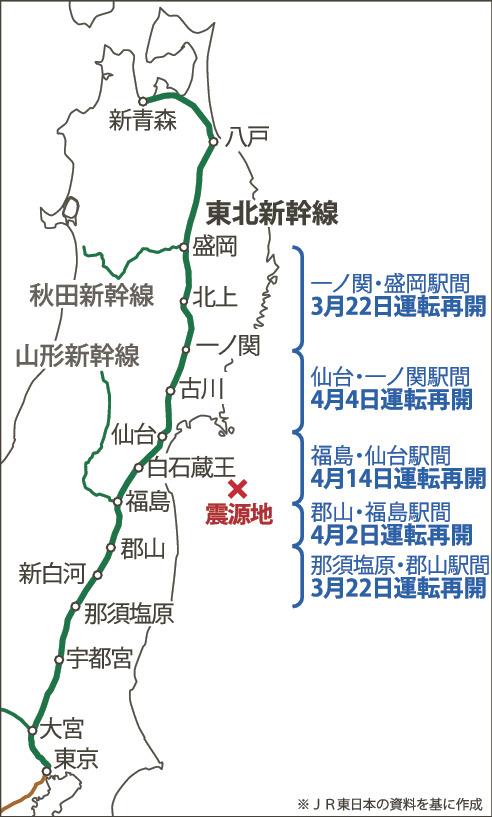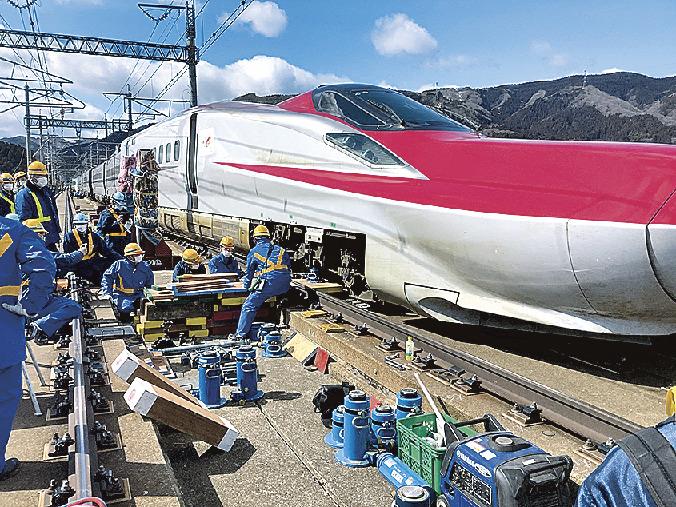1 month of Tohoku Shinkansen restoration 1 / JR East, all-out efforts to resume operations as soon as possible

Derailed vehicle loading work. It was one of the biggest missions for early recovery (provided by JR East)

The impact of the earthquake that occurred off the coast of Fukushima Prefecture on March 16th spread to various places, and JR East's railway facilities were also severely damaged. In particular, the Tohoku Shinkansen suffered extensive damage to structures and facilities, including derailment of trains, damage to viaducts, track displacement, and tilting and crushing of utility poles. The company leveraged past experiences from the 2004 Niigata Prefecture Chuetsu Earthquake, the 2011 Great East Japan Earthquake, and the Fukushima Prefecture Offshore Earthquake in February 2011. In a short period of about one month, we were able to resume operation on all lines. Tomorrow, the 16th, we will follow the trajectory from the earthquake to the restoration of the Tohoku Shinkansen for half a year.
(Tohoku Shinkansen restoration coverage group)
Due to this earthquake, which recorded a maximum seismic intensity of upper 6 in both Miyagi and Fukushima prefectures, the Tohoku Shinkansen was suspended between Nasushiobara and Morioka stations. According to JR East, damage to the Tohoku Shinkansen included approximately 60 civil engineering facilities, track displacement/damage in approximately 300 locations, station facilities in approximately 10 locations, utility poles in approximately 90 locations, overhead wire disconnection in two locations, and damage to overhead wire fittings in approximately 550 locations. There are about 1000 places in total.
"There were some parts between Fukushima and Sendai that shook in a way that exceeded the maximum value of the Great East Japan Earthquake."
Toshiaki Kuboki, Manager of the Civil Engineering Unit (Large-Scale Renovation Project Promotion Center) of the Railway Business Headquarters of JR East, speculates that the ease with which seismic waves propagate is related to the extent of damage.
Although there was no "severe damage" level damage, such as falling girders and slabs and broken columns, there was "medium damage" level damage, such as subsidence of girders and slabs and protruding rebar, at Sendai Station in Fukushima. Occurred at two elevated bridges in between. “Restoring the two moderately damaged trains and the derailment site was a major mission for the Civil Engineering Department,” says Kuboki.
Kazumi Oda, leader of the track maintenance unit of the Shinkansen Equipment Department, Shinkansen General Headquarters, said from the information on the seismic intensity and inspection area sent by e-mail immediately after the disaster, ``Isn't it about half a month since the earthquake was about the same scale as a year ago, when all lines resumed operation? "I imagined. However, after that, information such as vehicle derailment and damage to the elevated bridge came in one after another, and it was predicted that it would take a considerable amount of time to restore the service. After investigating the damage situation, it was found that the scale of track repairs handled by the track maintenance department was "approximately 1.4 times greater than the damage caused by the earthquake in February last year," according to Oda.
Fortunately in the midst of misfortune, the train derailed after it had made an emergency stop, limiting damage to the track around the scene. Oda explains, ``If the train had derailed while it was running, it would have destroyed all the jigs that hold the rails in place.'
As with last year's earthquake, there was conspicuous damage to electrical equipment such as tilting and breaking of utility poles, and metal fittings that support overhead lines. Takahiro Hamada, manager of the electric power unit of the Shinkansen electric network department at the headquarters, said, "Maybe because the shaking was bigger than last year, there were more than twice as many places where the pantographs were slightly bent."
The Tohoku Shinkansen, which was forced to suspend operation, quickly proceeded with inspections and restoration work, and on March 22nd, operations resumed sequentially, beginning with sections with the least damage. The last remaining section between Fukushima and Sendai stations resumed operation on April 14. Since it took time to repair overhead lines, the trains continued to run slowly between Koriyama Station and Ichinoseki Station even after the entire line resumed operation.
Following the response of JR East, the operator of the Tohoku Shinkansen restoration over the course of about a month, the efforts of the related companies involved in the restoration on the front lines will be spotlighted.






